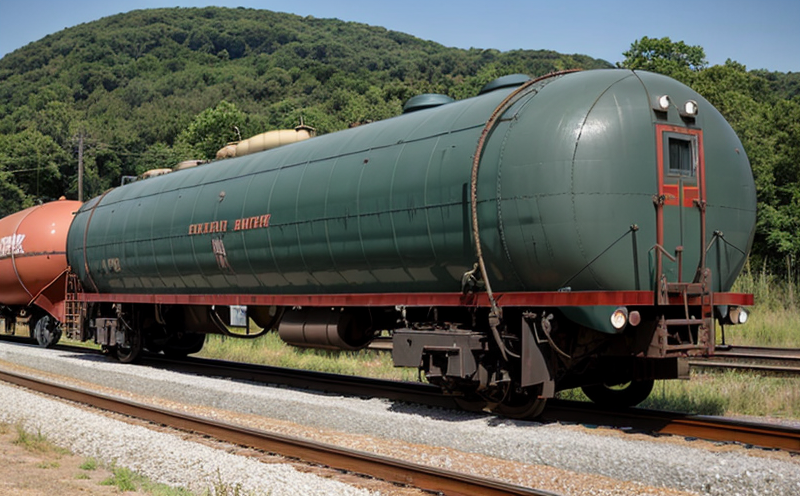Tanker railcar inspection
In the transportation and logistics sector, tanker railcars play a critical role in moving hazardous liquids such as petrochemicals, chemicals, and other flammable or corrosive materials. Ensuring these tankers are safe and compliant with regulatory standards is paramount to prevent accidents that could lead to environmental damage, property loss, and severe health risks.
The inspection process for tanker railcars involves a series of non-destructive testing (NDT) techniques designed to detect flaws or imperfections without compromising the integrity of the tank. This article will delve into the specifics of how these inspections are conducted, highlighting the importance of adhering to international standards and the advantages that come with choosing a reputable laboratory like Eurolab for this service.
The inspection process typically includes several key stages: pre-inspection preparation, visual examination, thickness measurement (UT), magnetic particle testing (MPI), ultrasonic testing (UT), radiographic testing (RT), and finally, the interpretation of results to ensure compliance with relevant standards. Each step is critical in ensuring that any potential issues are identified early on.
During pre-inspection preparation, it's important to clean and prepare the surface of the tank for thorough inspection. This ensures that any defects or imperfections aren't obscured by dirt or residue. Once prepared, a visual examination is conducted to identify any obvious signs of damage or wear. Following this, thickness measurements are taken using ultrasonic testing (UT) to assess the remaining wall thickness and detect potential thinning areas which could indicate internal corrosion.
Magnetic particle inspection (MPI) uses magnetic flux to reveal surface-breaking flaws in ferromagnetic materials. This method is particularly useful for detecting cracks or other defects that may not be visible through visual examination alone. Ultrasonic testing (UT) provides a more detailed analysis by measuring the depth and location of internal flaws within the tank walls.
Radiographic testing (RT), which involves exposing the tank to radiation, offers an even deeper insight into any structural issues inside the tank. By analyzing the resulting images, inspectors can identify any anomalies that could pose a risk. The final step in this process is interpreting these results against relevant standards and ensuring all findings are documented accurately.
Given the stringent safety requirements associated with transporting hazardous materials, it's crucial to follow rigorous testing protocols. This approach helps maintain high levels of reliability while minimizing the risk of accidents during transport. By adhering strictly to international standards like ISO 9712 for welding inspection and ASME Section VIII Division 1 for pressure vessels, Eurolab ensures that all inspections conducted meet industry best practices.
Thorough preparation is essential before any inspection can begin. This includes cleaning the tank surface thoroughly and preparing it appropriately for NDT techniques such as ultrasonic testing (UT), magnetic particle inspection (MPI), and radiographic testing (RT). Properly cleaned surfaces allow inspectors to detect even small defects more accurately.
The importance of following international standards cannot be overstated when performing tanker railcar inspections. These standards provide a framework for consistent, reliable testing methods across different regions and industries. For example, ISO 9712 specifies the qualifications required for personnel involved in non-destructive testing (NDT), while ASME Section VIII Division 1 sets guidelines for the design of pressure vessels. Adhering to these standards ensures that all inspections are conducted uniformly, leading to more accurate assessments and greater confidence in results.
By choosing a reputable laboratory like Eurolab for your tanker railcar inspection needs, you can be assured of top-tier service and expertise tailored specifically towards this demanding industry. With years of experience in conducting these types of inspections, we offer comprehensive solutions that meet all necessary requirements set forth by regulatory bodies.
Applied Standards
| Standard | Description |
|---|---|
| ISO 9712 | This standard sets out the qualifications and training requirements for personnel involved in non-destructive testing (NDT). |
| ASME Section VIII Division 1 | Provides design rules for pressure vessels, including those used in tanker railcars. |
| EN 473 | Defines the general principles and requirements for non-destructive testing (NDT) personnel qualifications. |
Eurolab Advantages
When it comes to tanker railcar inspection, Eurolab offers several key advantages that set us apart from other laboratories in the industry. Our highly experienced team of inspectors ensures that all testing is carried out with precision and accuracy, adhering strictly to international standards.
We employ state-of-the-art equipment capable of detecting even minute flaws within the tank walls, providing you with peace of mind knowing your assets are thoroughly checked. Additionally, our commitment to quality control means that every inspection undergoes rigorous review before final reports are issued.
Choosing Eurolab also gives you access to detailed documentation and comprehensive reports, which can be crucial for maintaining compliance with various regulations and ensuring safe operations throughout the lifecycle of your tanker railcars. Our services extend beyond just inspections; we offer expert advice on best practices for maintenance and repair as well.
International Acceptance and Recognition
- We are accredited to ISO/IEC 17025, ensuring our laboratory meets the highest quality standards.
- Our inspectors hold certifications from recognized bodies such as NDTI (Non-Destructive Testing Institute).
- Eurofins Group membership ensures global acceptance of our services and results.





